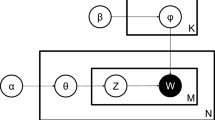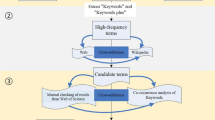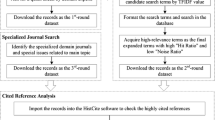Abstract
Developing useful intelligence on scientific and technological emergence challenges those who would manage R&D portfolios, assess research programs, or manage innovation. Recently, the U.S. Intelligence Advanced Research Projects Activity Foresight and Understanding from Scientific Exposition Program has explored means to detect emergence via text analyses. We have been involved in positing conceptual bases for emergence, framing candidate indicators, and devising implementations. We now present a software script to generate a family of Emergence Indicators for a topic of interest. This paper offers some background, then discusses the development of this script through iterative rounds of testing, and then offers example findings. Results point to promising and actionable intelligence for R&D decision-makers.




Similar content being viewed by others
Notes
When interpreting emergence results for patents users should be cognizant of the fact that a time-lag exists between the invention and innovation of the technology under study. While we have yet to fully explore the effect of this lag on emergence outcomes it is a noteworthy topic for future research.
We process the abstract records retrieved from databases, such as Web of Science, using VantagePoint desktop (Windows environment) software (www.theVantagePoint.com).
The script ran on the 13 k DSSC dataset used in this study in a matter of seconds.
Users can input data for derivative indicators from any field within the dataset they’re working with. In this paper we use fielded data at the author, organization and country level supplied by WOS. It’s up to the user’s discretion, however, to decide the inputs for these indicators. Different databases are likely to assign different definitions to the author, organization and country data they provide.
Average growth rate is calculated by subtracting the value associated with time period t from the value associated with time period t + 1, dividing the difference by the value associated with time period t and then taking the average of all results.
References
Alexander, J., John, C., Newman, N. C., Porter, A. L., & Roessner, D. (2012). Emergence as a conceptual framework for understanding scientific and technological progress. In PICMET (Portland International Conference on Management of Engineering and Technology), Vancouver, https://www.researchgate.net/profile/Jeffrey_Alexander/publication/248391856_Emergence_as_a_Conceptual_Framework_for_Understanding_Scientific_and_Technological_Progress/links/550847050cf26ff55f80c7b9.pdf.
Alexander, J., Murdick, D., Babko-Malaya, O., & Boyack, K. (2013). Detecting and evaluating the emergence of science and technology: Activities in foresight and understanding from scientific exposition. In Global Tech Mining Conference, Atlanta.
An, L., Lin, X., Yu, C., & Zhang, X. (2015). Measuring and visualizing the contributions of Chinese and American LIS research institutions to emerging themes and salient themes. Scientometrics, 105(3), 1605–1634.
Arora, S., Porter, A. L., Youtie, J., & Shapira, P. (2013). Capturing new developments in an emerging technology: An updated search strategy for identifying nanotechnology research outputs. Scientometrics, 95(1), 351–370.
Carley, S. F., Porter, Alan L., Newman, N. C., & Garner, J. G. (2017). A measure of staying power: Is the persistence of emergent concepts more significantly influenced by technical domain or scale? Scientometrics, 111(3), 2077–2087.
de Haan, J. (2006). How emergence arises. Ecological Complexity, 3(4), 293–301.
Ellis, A. K. (2010). Teaching and learning elementary social studies (9th ed.). New York: Pearson.
Foresight and Understanding from Scientific Exposition (FUSE). (2014). http://www.iarpa.gov/index.php/research-programs/fuse. Accessed March 18, 2016.
Garner, J., Carley, S. F., Porter, A. L., & Newman, N. C. (2017). Technological emergence indicators using emergence scoring. In Portland International Conference on Management of Engineering and Technology (PICMET), Portland, OR.
Goldstein, J. (1999). Emergence as a construct: History and issues. Emergence, 1(1), 49–72.
Guo, Y., Chen, X., Huang, L., & Porter, A. L. (2012a). Empirically informing a technology delivery system model for an emerging technology: Illustrated for dye-sensitized solar cells. R&D Management, 42(2), 133–149.
Guo, Y., Huang, L., & Porter, A. L. (2010). The research profiling method applied to nano-enhanced. Thin-film Solar Cells, R&D Management, 40(2), 195–208.
Guo, Y., Ma, T., Porter, A. L., & Huang, L. (2012b). Text mining of information resources to inform forecasting innovation pathways. Technology Analysis & Strategic Management, 24(8), 843–861.
Ma, T., Porter, A. L., Guo, Y., Ready, J., Xu, C., & Gao, L. (2014). A technology opportunities analysis model: Applied to dye-sensitized solar cells for China, Technology Analysis and Strategic Management, 26(1), 84–107. http://www.tandfonline.com/doi/full/10.1080/09537325.2013.850155.
Martin, B. R. (1995). Foresight in science and technology. Technology Analysis & Strategic Management, 7(2), 139–168.
O’Brien, J. J., Carley, S. F., & Porter, A. L. (2013). ClusterSuite [computer software], Atlanta, GA [available via VPInstute.org].
O’Regan, B., & Gratzel, M. (1991). A low-cost, high-efficiency solar-cell based on dye-sensitized colloidal TiO2 films. Nature, 353(6346), 737–740.
Roper, T., Cunningham, S., Porter, A. L., Mason, T., Rossini, F., & Banks, J. (2011). Forecasting and management of technology (2nd ed.). New York: Wiley.
Rotolo, D., Hicks, D., & Martin, B. R. (2015). What is an emerging technology? Research Policy, 44(10), 1827–1843.
Search Technology. (2012). www.thevantagepoint.com. Accessed March 19, 2016.
Small, H., Boyack, K., & Klavens, R. (2014). Identifying emerging topics in science and technology. Research Policy, 43(8), 1450–1467.
Zhang, Y., Porter, A. L., Hu, Z., Guo, Y., & Newman, N. C. (2014a). “Term clumping” for technical intelligence: A case study on dye-sensitized solar cells. Technology Forecasting & Social Change, 85, 26–39. https://doi.org/10.1016/j.techfore.2013.12.019.
Zhang, Y., Zhou, X., Porter, A. L., Vicente Gomila, J. M., & Yan, A. (2014b). Triple helix innovation in china’s dye-sensitized solar cell industry: Hybrid methods with semantic TRIZ and technology roadmapping. Scientometric, 99(1), 55–75.
Acknowledgements
This material is based upon work supported by the National Science Foundation under EAGER Award #: 1645237 for a Project, “Using the ORCID ID and Emergence Scoring to Study Frontier Researchers.” Any opinions, findings, and conclusions or recommendations expressed in this material are those of the author(s) and do not necessarily reflect the views of the National Science Foundation.
Author information
Authors and Affiliations
Corresponding author
Rights and permissions
About this article
Cite this article
Carley, S.F., Newman, N.C., Porter, A.L. et al. An indicator of technical emergence. Scientometrics 115, 35–49 (2018). https://doi.org/10.1007/s11192-018-2654-5
Received:
Published:
Issue Date:
DOI: https://doi.org/10.1007/s11192-018-2654-5




